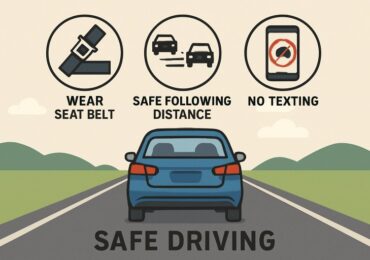Key Takeaways
- Practical road safety habits can drastically lower accident risk for all drivers.
- Staying aware of common causes and recent traffic data leads to better decisions.
- Modern technologies and simple precautions provide added protection on the road.
- Regular vehicle maintenance is crucial for reliable and safe travel.
- Understanding new research can help everyone adapt to changing traffic environments.
Why Road Safety Matters More Than Ever
Thousands of families are affected yearly by the devastating consequences of motor vehicle accidents. According to the Centers for Disease Control and Prevention, more than 38,000 lives are lost annually on U.S. roads. These statistics highlight the urgent need for practical road safety habits spanning every age group and experience level. For those seeking legal support following an accident, consulting a qualified Los Angeles car accident lawyer can guide you through complex situations and protect your rights.
Road safety isn’t just an individual responsibility—it’s a community effort. The ripple effects of a single car crash are far-reaching, impacting families, emergency services, and even the commuting public. Preventive driving measures safeguard each driver and foster safer neighborhoods and cities for everyone.
Common Risk Factors Every Driver Should Know
Most vehicle crashes stem from risky behaviors or preventable circumstances. Distractions from smartphones, GPS devices, or even in-car conversations lead to countless incidents, particularly among young drivers. Drowsy driving poses another hidden hazard that can be just as dangerous as driving under the influence. Seasonal hazards—such as rain, snow, or heavy fog—dramatically increase accident rates. Additionally, weekends and holidays often see a spike in collisions, typically due to higher traffic volumes and celebrations involving alcohol. Understanding these risk factors is essential for making informed decisions and reducing your chances of being involved in a crash.
By staying alert to changing road and weather patterns, drivers can plan their travel to minimize their exposure to high-risk conditions. That awareness is the first step toward developing genuinely safer habits behind the wheel.

Essential Habits for Safer Driving
- Always buckle up, no matter how short the trip.
- Keep a safe distance from other vehicles—use the “three-second rule.”
- Put phones away to resist the temptation of texting or scrolling.
- Stay within the speed limit and adapt to road conditions.
- Take breaks during long trips to avoid fatigue.
When practiced regularly, these habits become automatic. They lower accident risks and help create a calmer, more predictable driving environment for everyone sharing the road. Consistency in these small decisions can profoundly affect your mental well-being and road safety.
Can Technology Help Reduce Accidents?
Advancements in vehicle technology are providing drivers with more resources than ever before. Features such as adaptive cruise control, lane-keeping assistance, and automated emergency braking can be life-saving, particularly during distraction or fatigue. Even if you drive an older model, minor upgrades like adding a rearview camera or installing a tire pressure monitoring system can enhance your safety. However, it is always critical to remember that these devices are meant to support—not replace—active, attentive driving. Reliance on technology does not replace the need for fundamental road safety skills.
Independent research reported by Consumer Reports supports the effectiveness of these features, emphasizing the importance of using them in combination with alert driving habits. As innovation continues, all drivers must stay informed about emerging safety technology and how best to utilize it for everyday travel.
Keeping Your Vehicle Ready for the Road
Safe driving begins with a roadworthy vehicle. Preventive maintenance is the easiest way to avoid unnecessary incidents caused by mechanical failure. Here are a few practical steps to ensure your car is always ready:
- Check tire pressure and tread regularly.
- Make sure headlights and brake lights are working.
- Replace windshield wipers as soon as they streak.
- Schedule oil changes based on your manual’s recommendations.
- Keep an emergency kit with a flashlight, first aid, and water.
Taking time for routine checks can mean the difference between a safe trip and a preventable emergency. A well-maintained vehicle has fewer breakdowns and offers greater security for all its passengers.
What Recent Traffic Data Reveals
Traffic safety trends have experienced notable shifts in recent years. While total miles driven dropped during pandemic lockdowns, rates of speeding and reckless driving unfortunately increased, according to the National Highway Traffic Safety Administration. The surge in alternative transportation, like bicycling and electric scooters, has also increased the diversity and complexity of daily traffic. These trends make it vital for drivers to continuously adapt, watch for new hazards, and stay current with road safety information.
Adjusting to the Unexpected: Weather and Roadwork
Unpredictable changes, such as sudden storms or construction projects, require quick adaptation from drivers. Always reduce speed, increase your following distance, and stay extra alert in these conditions. If severe weather is forecasted, consider postponing your trip until it passes. Proactively checking route updates and leaving extra time for detours can make your journey safer. The combination of preparation and flexible thinking can often prevent minor inconveniences from turning into serious accidents.
Helping Teens and New Drivers Stay Safe
Supporting teens and new drivers is one of the most potent ways to improve road safety. Begin with strict ground rules: always buckle up, avoid cell phone use while driving, and obey speed limits. Supervised practice under various conditions—daytime and nighttime, dry and wet roads—builds lasting confidence and safe habits. Encouraging routine actions like regular mirror checks and signaling every turn prepares inexperienced drivers to handle the unexpected. Instilling these values early can shape safer driving for life.
Conclusion: A Safer Journey Starts Before You Turn the Key
Every safe trip starts with preparation. Plan your routes, check live traffic and weather updates, and leave extra time for unforeseen delays. While emerging technologies